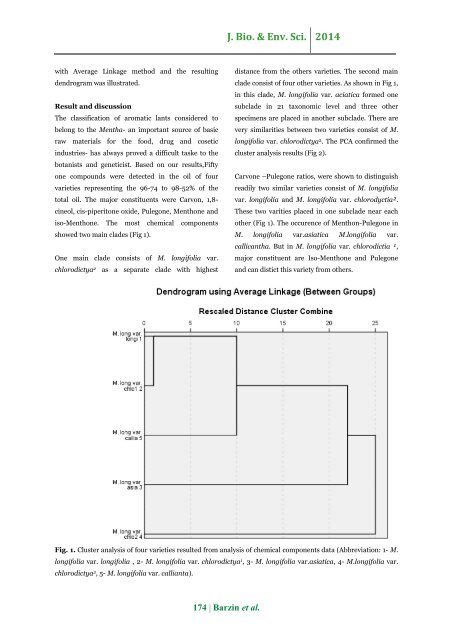Chemotaxonomy of four varieties of Mentha longifolia L. using essential oil composition markers
Abstract Mentha longifolia L. is one of the most important medicinal plant of Mentha genus. Studies were carried out to evaluate the chemotaxonomic relationships of four varieties of this specious. The evaluate oils were isolated and analytical gas chromatography was done. After determining 51 components, cluster analysis were used to determine the chemotaxonomy relationships between varieties. Based on 14 major essential oil components two main clades were shown. M. longifolia var. chlorodyctia had the highest distance from other varieties. It seems that environmental factors such as soil, nutrition and weather have the most effective influence on chemical composition and M. longifolia var. chlorodyctia introduced the best chemotype for this species.
Abstract Mentha longifolia L. is one of the most important medicinal plant of Mentha genus. Studies were carried out to evaluate the chemotaxonomic relationships of four varieties of this specious. The evaluate oils were isolated and analytical gas chromatography was done. After determining 51 components, cluster analysis were used to determine the chemotaxonomy relationships between varieties. Based on 14 major essential oil components two main clades were shown. M. longifolia var. chlorodyctia had the highest distance from other varieties. It seems that environmental factors such as soil, nutrition and weather have the most effective influence on chemical composition and M. longifolia var. chlorodyctia introduced the best chemotype for this species.
You also want an ePaper? Increase the reach of your titles
YUMPU automatically turns print PDFs into web optimized ePapers that Google loves.
J. Bio. & Env. Sci. 2014<br />
with Average Linkage method and the resulting<br />
dendrogram was illustrated.<br />
Result and discussion<br />
The classification <strong>of</strong> aromatic lants considered to<br />
belong to the <strong>Mentha</strong>- an important source <strong>of</strong> basic<br />
raw materials for the food, drug and cosetic<br />
industries- has always proved a difficult taske to the<br />
botanists and geneticist. Based on our results,Fifty<br />
one compounds were detected in the <strong>oil</strong> <strong>of</strong> <strong>four</strong><br />
<strong>varieties</strong> representing the 96-74 to 98-52% <strong>of</strong> the<br />
total <strong>oil</strong>. The major constituents were Carvon, 1,8-<br />
cineol, cis-piperitone oxide, Pulegone, Menthone and<br />
iso-Menthone. The most chemical components<br />
showed two main clades (Fig 1).<br />
One main clade consists <strong>of</strong> M. <strong>longifolia</strong> var.<br />
chlorodictya 2 as a separate clade with highest<br />
distance from the others <strong>varieties</strong>. The second main<br />
clade consist <strong>of</strong> <strong>four</strong> other <strong>varieties</strong>. As shown in Fig 1,<br />
in this clade, M. <strong>longifolia</strong> var. aciatica formed one<br />
subclade in 21 taxonomic level and three other<br />
specimens are placed in another subclade. There are<br />
very similarities between two <strong>varieties</strong> consist <strong>of</strong> M.<br />
<strong>longifolia</strong> var. chlorodictya 2 . The PCA confirmed the<br />
cluster analysis results (Fig 2).<br />
Carvone –Pulegone ratios, were shown to distinguish<br />
readily two similar <strong>varieties</strong> consist <strong>of</strong> M. <strong>longifolia</strong><br />
var. <strong>longifolia</strong> and M. <strong>longifolia</strong> var. chlorodyctia².<br />
These two varities placed in one subclade near each<br />
other (Fig 1). The occurence <strong>of</strong> Menthon-Pulegone in<br />
M. <strong>longifolia</strong> var.asiatica M.<strong>longifolia</strong> var.<br />
callicantha. But in M. <strong>longifolia</strong> var. chlorodictia ¹,<br />
major constituent are Iso-Menthone and Pulegone<br />
and can distict this variety from others.<br />
Fig. 1. Cluster analysis <strong>of</strong> <strong>four</strong> <strong>varieties</strong> resulted from analysis <strong>of</strong> chemical components data (Abbreviation: 1- M.<br />
<strong>longifolia</strong> var. <strong>longifolia</strong> , 2- M. <strong>longifolia</strong> var. chlorodictya 1 , 3- M. <strong>longifolia</strong> var.asiatica, 4- M.<strong>longifolia</strong> var.<br />
chlorodictya 2 , 5- M. <strong>longifolia</strong> var. callianta).<br />
174 | Barzin et al.





![Review on: impact of seed rates and method of sowing on yield and yield related traits of Teff [Eragrostis teff (Zucc.) Trotter] | IJAAR @yumpu](https://documents.yumpu.com/000/066/025/853/c0a2f1eefa2ed71422e741fbc2b37a5fd6200cb1/6b7767675149533469736965546e4c6a4e57325054773d3d/4f6e6531383245617a537a49397878747846574858513d3d.jpg?AWSAccessKeyId=AKIAICNEWSPSEKTJ5M3Q&Expires=1715043600&Signature=9tV2QFSfG0rgGlsU7MmpN%2BsOzV4%3D)












